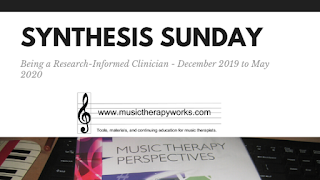Synthesis Sunday - Well...Not Really

This is supposed to be a Synthesis Sunday post, full of information about my current foray into music therapy, but I am on vacation and haven't done any of my post-it note work or synthesis. In fact, I need to go back to last week's post to see where I am in the process. I think I'm almost finished, but I'm not exactly sure...Oh. I stated that I would write about this article while here on vacation, so I am going to get my reading glasses and do some of this work.
But, I don't have any post-it notes.
What a lame excuse - just write on paper! You can do this.
Sigh. You're right, rational brain. I'll do it.
So, here's how my initial synthesis process goes...
Let's look at the abstract. Desire for social interaction with increased isolation and feelings of loneliness from peers. Singing, rhythmic games, creative movement, and dance - first intruding thought - how is creative movement different from dancing?? - dyads, small groups, large groups.
Justification for music as place to engage folks in interaction - offers several names I recognize - LaGasse, Peretz, Alvin & Warwick -
Here's a paragraph that I particularly like:
"Music therapy is the use of sounds and music within an evolving relationship between client and therapist to support and encourage physical, mental, social and emotional wellbeing (Bunt, 1996). From a social and communication perspective, music therapy is basically trying to make contact with another human being through music. We can observe how clients use the music and how problems may get in the way of interactive communication (Bunt, 1996). The literature demonstrates that s [sic] variety of the needs of individuals with ASD can be improved with music therapy treatment such as increasing engagement behavior, decreasing autistic-like behavior, improving emotional understanding, increasing emotional engagement and social skills including joint attention,
social greeting routines, and communication skills (LaGasse, 2014)" (p. 3).
I get that idea, and I REALLY like Bunt's definition of music therapy. It is very similar to my definition.
Back to fact collecting:
6 individuals - 3 male and 3 female between the ages of 13 and 18 - and 3 adults and 1 "student volunteer" - cameraman in all sessions - individuals showed interest in music as treatment form and were invited to the group. 2Xper month for 90 minutes - total of 8 sessions - qualitative review of video information - another quotation from the narrative:
"The planned music therapy interventions included activities such as greeting/name games; sharing individual ideas after any subject we experienced; playing pair games such as mirroring each other, finger/hand games; joint activities in group cohesion such as carrying a stone in a circle with the rhythm they listen, and listening each other’s creative solutions; creativity activities through developing a core idea from beginning to end, and improvisation activities such as finding a musical motive and work on it individually to express their own musical ideas which is related to their instant feelings. Additionally, movement, body percussion, circle dances, rhythm games and singing activities were performed" (p. 4).
Okay - this is the type of thing that I like to see in an article - some practical clinical descriptions of what they actually did during the interaction portion of this study. The author goes in to some more description of what clients experienced, and then there is a very short paragraph of conclusions - I want more information about what clients engaged in more readily than others and how the therapist used the music to encourage interaction - were there specific prompts to find a new partner? There were specific prompts to find partners, but I still want to know more.
Overall, this piece of research did not have much in the way of data presentation, but it did fulfill one of my basic needs when it comes to research - there were descriptions of what the researcher and the clients did during music therapy. It seemed to be the type of research that I could accomplish at my facility - something that uses the resources and services already present in a way that adds to the clinical body of knowledge.
I listen to a podcast (called the Bible Binge) that uses a wrap-up entitled "so what, who cares." I really like that, so here is my "so what, who cares?" element to all of this.
Why is this type of article so important to music therapists?
I know that many of us out there - mostly clinicians who do direct music therapy services for clients every day - want to increase our knowledge base but often have a disconnect with the research that is presented through our journals. We need more practical applications of music therapy. This article is one that I could take to my facility to support the addition of a new therapy group. It is easy to read and offers a persuasive argument for using music therapy for a specific purpose with a group of clients who often share specific needs. It describes a sequence of interactions to replicate within the individual music therapy clinics around the world. It offers ideas but not scripts - and that is the best type of research for me. I love it all!
I consider this one finished - all except for writing it formally on my Music Therapy Research-Informed Clinician Format - so it will be time to find something new to synthesize this next week. I'm still open to suggestions...
Eren. B. (2015). The use of music interventions to improve social skills in adolescents with autism spectrum disorder in integrated group music therapy sessions. Procedia Social and Behavioral Sciences, 197, 207-213. Retrieved from: www.sciencedirect.com


Comments
Post a Comment